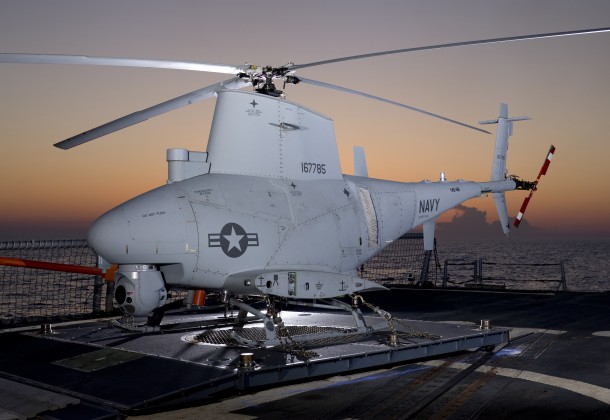Report: Fire Scout Not Meeting 30-Hour Reliability

By Jay Friess
Editor
The Pentagon’s Developmental Test and Evaluation and Systems Engineering report, signed by Ed Greer, former Naval Air Warfare Center Aircraft Division director, hit the streets this week. The beefy report contains plenty of updated commentary on the Navy’s developmental projects, including three undergoing testing at Naval Air Station Patuxent River.
The report provides updates on the E-2D Advanced Hawkeye radar and communications platform; the P-8A Poseidon submarine hunter; and the MQ-8B Fire Scout unmanned helicopter.
E-2D Advanced Hawkeye
Good news all around here: “Aircraft reliability is adequate and radar reliability is currently at 63 hours, which is sufficient to meet mission requirements. Prior concerns over computer instability have been addressed with resets reduced to less than one per flight. Built-in test performance has also improved to acceptable levels.”
P-8A Poseidon
The report repeated remarks that the program is behind schedule: “Maintenance, manpower shortages, and other issues have placed the test program about 8 weeks behind schedule. This resulted in slipping [Initial Operational Test and Evaluation] by about 8 weeks in FY 2012 but still well short of its threshold date.”
Still, lots of progress being made, including: “clean configuration flutter testing and captive carriage testing of the Mark 54 torpedo. The primary mission systems test article successfully completed its acoustics checkout, as well as communications, data link, radar, navigation, and fire suppression systems ground tests. The P-8A successfully tracked undersea targets off the Atlantic coast and completed its sonobuoy positioning characterizations. The aircraft successfully released sonobuoys, flares, smoke, and underwater sound signal device stores and successfully dropped a Mark 54 torpedo. The first production-representative aircraft joined the DT&E program briefly and successfully conducted missions against a noncooperative diesel submarine. The Software Integration Lab finished construction and entered operation at Naval Air Warfare Center, Patuxent River, Maryland. It simulates the full mission suite/crew, including the cockpit, and has been found to correlate well with actual flight data. The test team uses it to test new software builds, fly complete virtual missions including operational assessments, as well as prepare crews for complex missions, thus increasing flight test efficiency.”
The report says that IOT&E has slipped from April 2012 to June 2012, but notes, “This schedule still leaves margin before the Acquisition Program Baseline (APB) threshold IOT&E start date of October 2012.”
MQ-8B Fire Scout
The report notes the program’s ongoing technical problems: “The [Vertical Takeoff Unamanned Aerial Vehicle] program is at moderate risk for meeting the program schedule because of performance issues. Capability development continued in FY 2011 and IOT&E has been delayed until 2012, primarily because of suitability and voice communications relay issues. The system continues to experience operational mission reliability less than the requirement, interoperability issues with LCS ships, and link issues.”
The drone has not been tested on rough seas: “The deck pitch angle threshold for auto launch and recovery has been demonstrated to 2 degrees at sea, versus a 3degree requirement. Launch and recovery has been demonstrated up to 5 degrees pitch during previous land-based DTs; however, the sea states have not been rough enough to reach the required pitch conditions at sea.”
Endurance and communication problems persist: “The VTUAV has demonstrated 10 hours reliability during DT&E and approximately 18 hours during deployment – both significantly less than the 30-hour requirement. Based on prior field tests and the at-sea demonstrations, there are lingering performance issues with voice communication relay, target location errors, and data link persistence that are being addressed but whose corrections must be verified in testing in 2012.”























